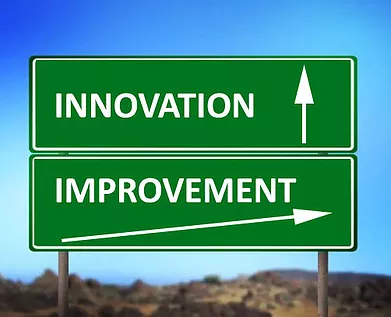The three “I’s” are critical to success and growth. What do they mean to sales and marketing? Why are they important to revenue generation functions, what should we be doing about them?
First, let’s start with some definitions:
An invention is a unique or novel device, method, composition or process. (Dave’s take: Something that has never existed before.)
Innovation is the practical implementation of ideas that result in the introduction of new goods or services or improvements in offering goods or services. (Dave’s take, something that may have existed before, but is being applied in a new or novel way.)
Improvement is the act or process of making something better. (Dave’s take, getting better at doing things.)
I’ll focus on Innovation and Improvement. Personally, except for the very first barter between Adam and Eve, I don’t believe there has been invention in Selling. Make no mistake, a lot the things that we sell represent great inventions. A lot of the companies and new business models represent invention, but how we sell, doesn’t represent invention, rather innovation and improvement.
Invention is very difficult. Coming up with something that has never existed before, that is completely new is rare. They are important, they enable us to do things we have never imagined before. But most of what we do with those inventions is innovation and improvement.
Let me start with improvement. Improvement is important to selling. It focuses on how we get better doing the things that create results. How do we engage our customers more effectively, how do we create greater value with them, how do we build strong relationships and trust, how do we grow them, how do we help them make sense of what they face, how do we incite them to change……
As we look at our own organizations, there are issues like, How do we make sure we are hiring the right people, how do we onboard them as quickly as possible, how do we help them maximize their performance, how do we make sure we are providing the right tools, processes, systems, training, and coaching, how do we improve how we deploy our people do maximize performance…..
There are many things that we can look at to improve on what we already do with our customers or how we work within our organizations. Generally, in looking at improvement, we must look at effectiveness–which is are we doing something in the best way possible; followed by efficiency–which is are we doing these things in as little time as possible. Effectiveness and efficiency go hand in hand–but in that sequence. Improvement drives us to work more consistently–individually and across the organization. Improvement focuses on reducing variation. We need to continuously look at these figuring out how we get more effective and efficient.
Improvement generally doesn’t drive huge leaps or changes in performance, but enables us to take lots of little steps that drive better levels of performance. Improvement focuses on incremental change.
Innovation drives huge increases in performance. Innovation overlaps with both invention and improvement, so sometimes it’s hard to understand the differences.
Innovation may look a lot like invention. It may be something entirely new to us, perhaps adapted from something/someone/somewhere else. It requires us to shift the paradigm. In some sense, where improvement looks an reducing variation, innovation introduces huge variation. For example moving from a sales led customer engagement model to a digitally led customer engagement model may represent huge innovation within our organization or our markets–yet these have been common for years in consumer markets. Changing our deployment model from a direct sales to a channel led approach may represent an innovation.
Innovation can also be taking things we already do, applying it to different markets, or with different products/solutions. In this sense, these are new in how they are used are used and who uses them. This type of innovation requires us to think about what we have to change to achieve our goals in these new applications.
Sometimes innovation looks a lot like improvement. For example, a new sales methodology to improve sales performance, a new tool to improve productivity. These may be new to us, well established in other spaces. But where improvement drives incremental change, innovation drive step function change.
Often, when we think about improvement and innovation, we look at it internally, how we get better, how we change, how we improve our own capabilities and performance.
However, we create great value helping our customers improve and innovate.
Perhaps, we show them ideas about how to drive improvement in their own operations. Perhaps we show them how to improve their effectiveness, efficiency, and productivity. We enable them to do what they already do, but better. And that helps reduce cost, improve quality, drive growth, improve their customer satisfaction, improve profitability.
We can help our customers innovate, help them discover things that are new to them, that help them think differently. We can help them discover how/why they might change to more effectively achieve their goals, to work better–differently. Perhaps, most importantly, we can help them discover how they might better serve their customers, creating greater value for them.
Innovation and improvement is critical–both for how we change, learn things new to us, do things differently. And how we help our customers do those for themselves.
Perhaps a way to develop our own skills in innovation and improvement, is to first innovate and improve what we do, taking that experience and lessons to our customers, based on our experience.
But whatever we do, innovation and improvement are critical!

Leave a Reply